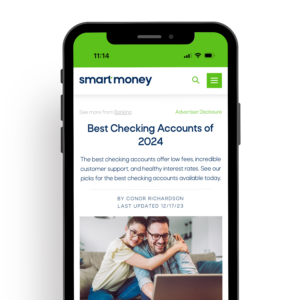Takeaways
- Student loans are long-term debt that allow students to pay for higher education.
- Student loans are repaid with interest over time, usually starting after graduation.
- Student loans can be bucketed into two main types: federal or private student loans.
- Student loans include variables like interest rates, repayment terms, and forgiveness.
- Student loans include Direct Subsidized Loans, Direct Unsubsidized Loans, Direct PLUS Loans, and Direct Consolidation Loans.
You are not alone if you are considering student loans to finance your pursuit of higher education, like college or graduate school. After exhausting all the free money options like merit-based scholarships, grants, or academic fellowships, the next best option could be to think about using student loans to finance your education.
Student loans have become a cornerstone to financing education in the U.S., providing access to millions of students who aspire to achieve academic excellence and pursue their dreams but lack the financial resources to pay for school with cash. Newly accepted college and graduate students must face the current maze of student loans. This involves learning new financial definitions like interest, repayment terms, principal, and minimum payments.
Approximately 61% of people with a bachelor's degree leave college with an average student loan debt of over $28,100. Recent graduates have realized that student loan debt can hinder traditional adult milestones, like buying your first house, investing in stocks, or getting married. Student loans can affect your employment and where you want to work after graduation. Let’s look at how successfully navigating student loans can set you up for success.
What Are Student Loans?
A student loan is a financial agreement between you and a lender, which stipulates you will borrow funds from the lender with the understanding you will pay back the principal with interest. The amount you borrow for a student loan helps cover costs associated with higher education.
The total costs of higher education can include expenses like tuition payments, textbooks, dorm or apartment costs, and other essential expenses incurred while pursuing your degree. Unlike grants or scholarships (which do not require repayment because they are given based on merit or financial need), student loans are paid over time with interest.
Student loans essentially give you the cash you need to pay for school. These financial agreements are made with the federal government or private student loan providers. The rule of thumb is to exhaust all available options before taking out student loans. However, you should ensure you have maximized your federal student loans before taking out private loans.
How Do Student Loans Work?
Before you even take out a student loan, the first step is to apply to a college, university, or graduate school that you want to attend. Get an understanding of the total cost of attendance and figure out how you are going to pay for school.
This process usually starts with a candid conversation with your family about how much they can and will fund your education. Once you get a keen sense of how much you must work with, you can start thinking about personal loans.
After you are accepted to the program you are going to attend, it is time to get down to brass tacks. You need to understand the minimum amount you need to borrow and be prepared to give yourself a financial buffer.
Federal and private student loans are there to provide you with financial assistance. However, you must repay the money you borrow with interest after completing your education. Repayment typically begins after you graduate, withdraw from school, or enroll below a certain credit threshold. Student loan terms vary based on the loan agreements so pay attention to your loan’s details.
After graduation, you will have to pay off your student loans. This will consist of a monthly payment or required minimum payments. If you want to pay off your loans quickly, you can try getting a raise to earn more income, start your own online business, or get a side hustle. Throwing more money at your principal amount will whittle it down until you are debt free.
Get Smart With Your Money
Fresh weekly articles delivered straight to your inbox.
Enter your name and email for free tips and tricks.

Considerations for Using Student Loans
Not all student loans are equal. Before you sign on the dotted line for a student loan, you should read the agreement carefully and analyze critical variables in every student loan. Here are four factors to consider:
1. Interest Rates
Understand the interest rates associated with different loan options, as they can significantly impact the total amount repaid over time. Federal student loans typically offer fixed interest rates, providing borrowers with stability and predictability in repayment.
Private student loan lenders can provide fixed interest rates or variable rates that fluctuate over time based on market conditions. Variable interest rates can be tethered to the federal funds rate, LIBOR, or another benchmark.
2. Repayment Terms
Familiarize yourself with the repayment terms of each loan, including the duration of the repayment period, grace periods, and any available options for deferment or forbearance. Be aware of the implications of different repayment plans.
Some repayment terms can also offer income-based options. You should review each agreement carefully and choose the best fit for your situation and financial goals.
3. Financial Need
Assess your financial need objectively and borrow only what is necessary to cover educational expenses. Explore alternative funding sources, such as scholarships, grants, or part-time work, before resorting to loans to minimize your debt burden after graduation.
4. Loan Forgiveness and Repayment Options
It is vital to understand that a student loan is a serious financial commitment. Most people sign the agreement with the understanding that they will make a good-faith effort to pay off their loans after graduation. However, variables like the broader economic environment, the salary of your profession, and individual circumstances can sometimes make it hard to find full employment after graduation.
Smart Money -> How to Get The Raise Your Deserve
Because of this, it is always wise to research potential loan forgiveness programs and alternative repayment plans offered by federal loans, such as income-driven repayment options or public service loan forgiveness. These programs can relieve borrowers facing financial hardships and facilitate manageable repayment strategies.
Main Types of Student Loans
Student loans are financed by two types of lenders, the federal government and private student loan providers. Here are the differences between the two options:
1. Federal Student Loans
Funded by the federal government, these loans offer numerous benefits and protections for borrowers. Federal loans typically have lower interest rates than private loans, flexible repayment options, and opportunities for loan forgiveness or discharge under certain circumstances.
2. Private Student Loans
Private lenders, such as banks or credit unions, offer personal student loans as an alternative financing option for students who have exhausted federal aid or require additional funds to meet their educational expenses. Private loans may have variable interest rates and fewer borrower protections than federal loans.
What Type of Debt Are Student Loans?
Student loans are considered a type of consumer debt. Although most student loans are taken out by young students, these loans are a serious long-term financial commitment that can affect your finances for decades. Ignoring your student loans won't make them disappear. Just like any other consumer debt, such as credit cards, auto loans, and mortgages, student loans come with the expectation that you will repay the principal you have borrowed plus interest.
Consumer debt can be broken into two primary categories: secured and unsecured debt. Here is how they are different:
- Secured Debt: Secured debt is tethered to collateral, like a co-signer, car, or house. If you don’t repay the loan, the lender can take possession of your collateral for repayment.
- Unsecured Debt: Unsecured debt is not backed by collateral and is simply your promise to pay. However, failure to repay can seriously impact your credit score.
Student loans fall squarely into the unsecured category. However, student loans are not treated like other unsecured debts if you start missing payments. You see, with other unsecured debts like credit cards or personal loans, the consequences usually involve some form of collection efforts from the creditor. Missed payments, late payments, and underpayment can all show up on your credit report. This can damage your credit score and affect your ability to borrow in the future.
Learn More -> What is a FICO Credit Score?
But student loans are a bit different. Since there is typically no collateral involved or another person to go after if you default (unless you have a Co-signer), the consequences can get more serious. Failing to keep up with student loan payments could land you in uncomfortable financial situations, like garnishing your wages or legal action. So, when it comes to student loan debt, stay on top of those payments to avoid unwanted surprises.
Get Smart -> How to Increase Your Credit Score by 100 Points
4 Types of Federal Student Loans
There are four main types of federal student loans. Each of these options has its unique draw and features that may suit your financial situation. Here are the differences between each type of loan:
1. Direct Subsidized Loans
Available to undergraduate students with demonstrated financial need, subsidized loans offer favorable terms, including interest subsidies during specific periods, to alleviate the financial burden on borrowers. To see if you qualify for subsidized federal student loans, you should fill out the Free Application for Federal Student Aid (FAFSA). Subsidized loans are generally federal student loans [1].
For federally subsidized loans, the federal government subsidizes (pay the interest on your loan) while you are attending school. However, you must start paying interest on a subsidized loan:
- Six months after you graduate
- Drop below the half-time enrollment status requirement
- Leave school
2. Direct Unsubsidized Loans
Offered to undergraduate and graduate students regardless of financial need, unsubsidized loans accrue interest from the disbursement date and require borrowers to assume responsibility for all interest charges incurred. Your school determines how much you can borrow with a direct unsubsidized loan. The school factors in the cost of attendance and other financial aid you get [2].
Smart Tip:
For direct unsubsidized loans, there can be periods where you are not required to pay interest payments. However, interest still accumulates during these times and can sometimes be added to your principal debt repayment plan to ensure your debt-to-income ratio does not get too high.
3. Direct PLUS Loans
Available for graduate or professional students and parents of undergraduate students, PLUS loans provide additional funding to cover educational expenses not met by other financial aid. For direct PLUS loans, the federal government is your lender, and they have a slightly higher bar for issuance. PLUS loans require a credit check and may have higher interest rates than other federal loans.
Common student loan terms:
- Parent Plus Loans: A direct PLUS loan made to a parent.
- Grad PLUS loan: A direct PLUS loan made to a graduate or professional student.
Like direct unsubsidized loans, the total amount you can receive from a direct PLUS loan is also determined by your school. The total amount you can borrow is capped at the total cost of attendance minus any other financial aid you might have already received [3].
4. Direct Consolidation Loans
Consolidation loans allow borrowers to combine multiple federal student loans into a single loan, streamlining repayment and simplifying the management of numerous loan accounts. Consolidation may extend the repayment period, potentially reducing monthly payments but increasing the total interest paid over time.
Applying for a direct consolidation loan from the U.S. Department of Education only takes minutes. You will need an FSA ID, personal and financial details, and loan information. Apply for the direct consolidation loan here.
Smart Summary
If you are considering taking out student loans, it is essential to approach borrowing cautiously and consider the long-term implications of debt. You will have to pay off your student loans. Prioritize financial responsibility and only borrow what you need to keep your cost of education as low as possible. Grasping the nuances of student loans will let you navigate the complexities of financing and lay the foundation for a successful academic and professional future.
(1) Consumer Financial Protection Bureau. What is a subsidized loan? Last Accessed March 23, 2024.
(2) Financial Student Aid. Direct Subsidized and Direct Unsubsidized Loans. Last Accessed March 23, 2024.
(3) Financial Student Aid. PLUS Loans. Last Accessed March 23, 2024.










